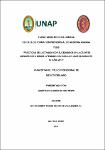| dc.contributor.advisor | Chuecas Velásquez, Eduardo Tomás | |
| dc.contributor.author | Arbildo Mathews, Gianfranco | |
| dc.date.accessioned | 2021-04-23T16:19:09Z | |
| dc.date.available | 2021-04-23T16:19:09Z | |
| dc.date.issued | 2021 | |
| dc.identifier.uri | https://hdl.handle.net/20.500.12737/7222 | |
| dc.description.abstract | La práctica de Lactancia Materna Exclusiva desde el nacimiento hasta el sexto mes de vida del niño, ha sido promovida como tal desde finales de los años 70. Sin embargo, aún se pueden encontrar prácticas inadecuadas de alimentación complementaria. Por lo que el objetivo del presente estudio es describir las prácticas de lactancia con sucedáneos en lactantes menores de 6 meses atendidos en Essalud Iquitos durante el año 2019. Para ello se realizó un estudio de tipo descriptivo. Concluyendo que el 13 % de las madres refieren haberle dado algún tipo de leche artificial al lactante durante el periodo postparto, el 13 % de las participantes aceptaron haber solicitado ayuda con algún tipo de leche para su bebé y el 3% de las madres aceptaron haber recibido recomendaciones de algún tipo de fórmula al momento del alta del Hospital, el 6 % de las participantes aceptó haber solicitado la recomendación de alguna fórmula para utilizarla al salir del Hospital. El 38 % de las madres refirieron haberle ofrecido algún tipo de leche artificial al neonato durante la primera y segunda semana, de ellas el 37 % refieren haberlo hecho debido a que los senos no los tenían lleno, la mayoría de ellas (22%) que ofrecieron a su bebé leche artificial el 22 % refiere que fue recomendado en la farmacia, el 12 % en el hospital y el 4 % refiere que le brinda leche artificial a su bebé por recomendación de otras personas. Respecto al uso de fórmulas durante los 6 primeros meses se encontró que el 13 % de las participantes refirieron que continúan ofreciéndole a su bebé la misma leche artificial durante este periodo, el 25 % refieren darle otro tipo de leche y el 62 % refieren que su bebé solo continúa recibiendo leche materna. El 1 % refieren haberle ofrecido al niño algún tipo de leche no maternizada como leche evaporada u otro tipo de leche en polvo. Se observó un incremento en el uso de leche artificial del 13 % al 38 % durante las 2 primeras semanas de vida del bebé. | es_PE |
| dc.description.abstract | The practice of Exclusive Breastfeeding from birth to the sixth month of the child's life has been promoted as such since the late 1970s. However, inadequate complementary feeding practices can still be found. Therefore, the objective of this study is to describe breastfeeding practices with substitutes in infants under 6 months of age attended at Essalud Iquitos during 2019. For this, a descriptive study was carried out. Concluding that 13% of the mothers report having given some type of artificial milk to the infant during the postpartum period, 13% of the participants agreed to have requested help with some type of milk for their baby and 3% of the mothers agreed to have received recommendations of some type of formula at the time of discharge from the Hospital, 6% of the participants accepted having requested the recommendation of some formula to use when leaving the Hospital. 38% of the mothers reported having offered some type of artificial milk to the newborn during the first and second week, of them 37% reported having done it because their breasts were not full, most of them (22%) that 22% of them offered artificial milk to their baby that it was recommended in the pharmacy, 12% in the hospital and 4% reported that they gave their baby artificial milk on the recommendation of other people. Regarding the use of formulas during the first 6 months, it was found that 13% of the participants reported that they continue to offer their baby the same artificial milk during this period, 25% report giving them another type of milk and 62% report that their baby just continues to receive breast milk. 1% report having offered the child some type of non-formula milk such as evaporated milk or another type of powdered milk. An increase in the use of artificial milk from 13% to 38% was observed during the first 2 weeks of the baby's life. | en_US |
| dc.format | application/pdf | es_PE |
| dc.language.iso | spa | es_PE |
| dc.publisher | Universidad Nacional de la Amazonía Peruana | es_PE |
| dc.rights | info:eu-repo/semantics/openAccess | es_PE |
| dc.rights.uri | https://creativecommons.org/licenses/by/4.0/ | es_PE |
| dc.subject | Lactancia | es_PE |
| dc.subject | Sucedaneos de la leche materia | es_PE |
| dc.subject | Niños | es_PE |
| dc.title | Prácticas de lactancia con sucedáneos en lactantes menores de 6 meses, atendidos en Essalud-Iquitos durante el año, 2019 | es_PE |
| dc.type | info:eu-repo/semantics/bachelorThesis | es_PE |
| thesis.degree.discipline | Medicina Humana | es_PE |
| thesis.degree.grantor | Universidad Nacional de la Amazonía Peruana. Facultad de Medicina Humana | es_PE |
| thesis.degree.name | Médico Cirujano | es_PE |
| dc.subject.ocde | http://purl.org/pe-repo/ocde/ford#3.03.04 | es_PE |
| renati.author.dni | 45815460 | |
| renati.advisor.dni | 05263634 | |
| renati.type | http://purl.org/pe-repo/renati/type#tesis | es_PE |
| renati.discipline | 912016 | es_PE |
| renati.level | http://purl.org/pe-repo/renati/level#tituloProfesional | es_PE |
| renati.juror | Villacorta Vigo, Edwin | |
| renati.juror | Magallanes Castilla, Jesús Jacinto | |
| renati.juror | Rodríguez Ferrucci, Hugo Miguel | |
| dc.publisher.country | PE | es_PE |


